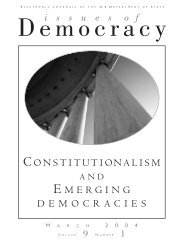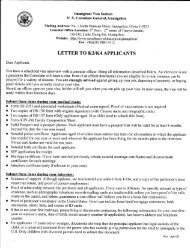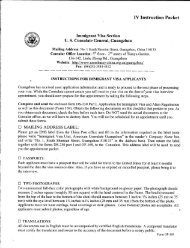s. history us history us history - Embassy of the United States
s. history us history us history - Embassy of the United States
s. history us history us history - Embassy of the United States
- No tags were found...
Create successful ePaper yourself
Turn your PDF publications into a flip-book with our unique Google optimized e-Paper software.
OUTLINE OF U.S. HISTORYTop, <strong>the</strong> World War II Memorial, opened in 2004, is <strong>the</strong> most recent addition to<strong>the</strong> many national monuments in Washington, D.C. It honors <strong>the</strong> 16 million whoserved in <strong>the</strong> armed forces <strong>of</strong> <strong>the</strong> <strong>United</strong> <strong>States</strong>, <strong>the</strong> more than 400,000 who died,and all who supported <strong>the</strong> war effort from home. Above, <strong>the</strong> planned design for<strong>the</strong> World Trade Center Memorial in New York City is depicted in this photograph<strong>of</strong> a model unveiled in late 2004. “Reflecting Absence” will preserve not only <strong>the</strong>memory <strong>of</strong> those who died in <strong>the</strong> terrorist attack <strong>of</strong> September 11, 2001, but <strong>the</strong>visible remnants <strong>of</strong> <strong>the</strong> buildings destroyed that morning, too.machine, and <strong>the</strong> reaper-thresher orcombine. Mechanical planters, cutters,h<strong>us</strong>kers, and shellers appeared,as did cream separators, manurespreaders, potato planters, hay driers,poultry incubators, and a hundredo<strong>the</strong>r inventions.Scarcely less important than machineryin <strong>the</strong> agricultural revolutionwas science. In 1862 <strong>the</strong> MorrillLand Grant College Act allottedpublic land to each state for <strong>the</strong> establishment<strong>of</strong> agricultural and ind<strong>us</strong>trialcolleges. These were to serveboth as educational institutions andas centers for research in scientificfarming. Congress subsequentlyappropriated funds for <strong>the</strong> creation<strong>of</strong> agricultural experiment stationsthroughout <strong>the</strong> country and grantedfunds directly to <strong>the</strong> Department <strong>of</strong>Agriculture for research purposes.By <strong>the</strong> beginning <strong>of</strong> <strong>the</strong> new century,scientists throughout <strong>the</strong> <strong>United</strong><strong>States</strong> were at work on a wide variety<strong>of</strong> agricultural projects.One <strong>of</strong> <strong>the</strong>se scientists, MarkCarleton, traveled for <strong>the</strong> Department<strong>of</strong> Agriculture to R<strong>us</strong>sia. Therehe found and exported to his homeland<strong>the</strong> r<strong>us</strong>t- and drought-resistantwinter wheat that now accountsfor more than half <strong>the</strong> U.S. wheatcrop. Ano<strong>the</strong>r scientist, MarionDorset, conquered <strong>the</strong> dreaded hogcholera, while still ano<strong>the</strong>r, GeorgeMohler, helped prevent ho<strong>of</strong>-andmouthdisease. From North Africa,one researcher brought back Kaffircorn; from Turkestan, ano<strong>the</strong>rimported <strong>the</strong> yellow-flowering alfalfa.Lu<strong>the</strong>r Burbank in Californiaproduced scores <strong>of</strong> new fruits andvegetables; in Wisconsin, StephenBabcock devised a test for determining<strong>the</strong> butterfat content <strong>of</strong> milk; atT<strong>us</strong>kegee Institute in Alabama, <strong>the</strong>African-American scientist GeorgeWashington Carver found hundreds<strong>of</strong> new <strong>us</strong>es for <strong>the</strong> peanut, sweet potato,and soybean.In varying degrees, <strong>the</strong> explosionin agricultural science and technologyaffected farmers all over <strong>the</strong>world, raising yields, squeezing outsmall producers, and driving migrationto ind<strong>us</strong>trial cities. Railroadsand steamships, moreover, began topull regional markets into one largeworld market with prices instantlycommunicated by trans-Atlanticcable as well as ground wires. Goodnews for urban consumers, fallingagricultural prices threatened <strong>the</strong>livelihood <strong>of</strong> many American farmersand touched <strong>of</strong>f a wave <strong>of</strong> agrariandiscontent.THE DIVIDED SOUTHAfter Reconstruction, Sou<strong>the</strong>rnleaders p<strong>us</strong>hed hard to attract ind<strong>us</strong>try.<strong>States</strong> <strong>of</strong>fered large inducementsand cheap labor to investors to develop<strong>the</strong> steel, lumber, tobacco, andtextile ind<strong>us</strong>tries. Yet in 1900 <strong>the</strong>region’s percentage <strong>of</strong> <strong>the</strong> nation’sind<strong>us</strong>trial base remained about whatit had been in 1860. Moreover, <strong>the</strong>price <strong>of</strong> this drive for ind<strong>us</strong>trializationwas high: Disease and childlabor proliferated in Sou<strong>the</strong>rn milltowns. Thirty years after <strong>the</strong> CivilWar, <strong>the</strong> South was still poor, over-176177












